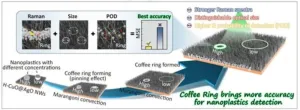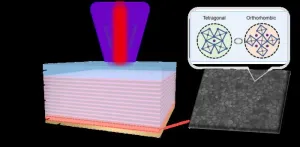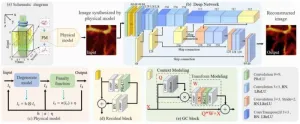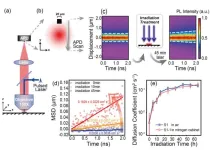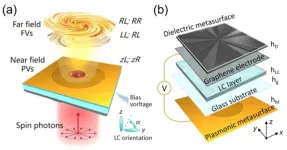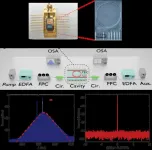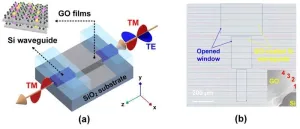A new publication from Opto-Electronic Advances; DOI 10.29026/oea.2025.240260 discusses a novel strategy for detecting trace-level nanoplastics in aquatic environments.
Plastic materials have revolutionized human lifestyles through their versatile applications, yet their environmental legacy now presents critical challenges to global ecosystems and public health. Current models estimate annual plastic influx into aquatic systems at 4.8-12.7 million metric tonnes, with projections suggesting cumulative marine plastic accumulation could reach 12 billion metric tonnes by mid-century an environmental crisis demanding urgent scientific attention. Nanoplastics are one of the many plastic wastes that are usually less than 1 μm in size, it has multiple sources, is widely distributed in soil and water environments, and can enter the body through breathing and eating. Nanoplastics present unique biological hazards, possessing enhanced capacity to traverse biological barriers through cellular membrane penetration while serving as persistent organic pollutant vectors through surface adsorption, thereby amplifying ecotoxicological impacts.
There are many methods for detecting nanoplastics, including transmission/scanning electron microscopy, dynamic light scattering, nanoparticle tracking analysis. Among the many detection methods for nanoplastics, surface-enhanced Raman spectroscopy (SERS) is an electromagnetic field enhancement phenomenon mainly based on the resonance of light between precious metal particles, can not only accurately reflect the chemical bonding information of the nanoplastics to be tested, but also provide high-resolution imaging of the morphology of the nanoplastics to be tested, and thus has received widespread attention in the field of nanoplastics detection.
However, critical limitations persist in translating this technology to environmental monitoring applications, particularly regarding quantitative analysis of trace-level nanoplastics. Field samples typically contain nanoplastic concentrations in the μg/L range, where conventional SERS substrates demonstrate insufficient sensitivity for practical monitoring requirements. This analytical challenge stems from fundamental physical constraints: at ultralow concentrations, stochastic nanoparticle distribution creates sparse deposition patterns where interparticle distances exceed typical laser spot dimensions (~1 μm). This spatial dispersion results in minimal signal variance across concentration gradients, as most sampled regions contain comparable nanoparticle counts, effectively nullifying intensity-based quantification methods dependent on characteristic peak amplitude variations.
To address these challenges, a research team from the School of Physics and Electronic Science at Shandong Normal University has proposed an innovative SERS detection strategy leveraging the coffee ring effect. Experimentally, the team first developed a superhydrophobic CuO/Ag SERS substrate with enhanced sensitivity to generate the coffee ring effect. Crucially, they employed an infrared radiation technique during the hydrophobic modification process, effectively eliminating potential interference caused by traditional organic modifiers such as fluorosilanes and stearic acid. This methodological advancement ensures cleaner spectral signatures while maintaining substrate functionality for precise nanoplastic detection.
The experimental results further demonstrated that when a nanoplastic-containing solution is deposited on this substrate surface, the Marangoni flow within the droplet transports "coffee particles" (nanoplastics) toward the droplet periphery, forming a distinct coffee ring upon drying. Owing to the pinning effect, nanoplastics become concentrated within the coffee ring structure, effectively addressing the challenge of insufficient Raman signal differentiation caused by nanoparticle dispersion at low concentrations. During experimentation, the research team observed an inverse correlation between the inner diameter of the coffee ring and nanoplastic concentration in the solution. Moreover, the coffee ring's enrichment effect enables efficient Raman mapping scans within smaller detection areas even at low nanoplastic concentrations, yielding abundant valid spectral data. Notably, the detection probability of valid Raman spectra within the scanned area also exhibits an inverse relationship with nanoplastic concentration. This dual observation establishes a novel quantification framework: at low concentrations, nanoplastic levels can be determined not only through spectral identification but also via coffee ring diameter measurements and detection probability analysis within the ring.
Remarkably, the superhydrophobic CuO/Ag SERS substrate not only generates intense electromagnetic hot spots for signal enhancement but also provides multiple concentration-dependent detection parameters. By integrating machine learning algorithms to analyze three distinct features (signal intensity, coffee ring diameter, and detection probability) through multivariate analysis, the team achieved breakthrough quantification performance. Across a broad concentration range (1% to 10-10%), the multivariate approach demonstrated mean squared errors (MSE) of 0.54 (PLSR) and 0.21 (SVR)—a 19-fold improvement over traditional linear regression based solely on characteristic peak intensity variations (MSE=4.06). Furthermore, this method achieved an ultralow quantification limit of 10-10%, establishing unprecedented sensitivity for environmental nanoplastic detection.
This work innovatively combines SERS technology with surface wettability engineering, simultaneously preserving the technique's inherent advantages of high sensitivity and molecular fingerprint specificity while overcoming the critical limitation of unreliable Raman intensity-concentration correlations at ultralow analyte levels. The demonstrated operational practicality establishes a transformative framework for nanoplastic detection, offering a novel paradigm for conducting precise SERS-based measurements in environmental monitoring scenarios. This methodological breakthrough holds significant implications for advancing risk assessment protocols and developing mitigation strategies against nanoplastic contamination in agricultural ecosystems.
Keywords: quantitative detection of trace nanoplastics / surface-enhanced Raman scattering / coffee ring / multiplex-feature analysis / machine learning
# # # # # #
Jing Yu (corresponding author of this paper) is an Associate Professor at the School of Physics and Electronics, Shandong Normal University. His long-term research focuses on innovative explorations of structural light field manipulation in surface-enhanced Raman scattering (SERS) and analytical model development. Currently, he leads the "Ultra-Sensitive In-Situ Spectral Detection Innovation Team" supported by the Shandong Provincial Higher Education Youth Innovation Science and Technology Support Program. He has completed five national and provincial/ministerial-level research grants as principal investigator.
Over the past five years, he has published over 30 SERS-related papers as first or corresponding author in prominent SCI-indexed journals including Opto-Electronic Advances, Advanced Functional Materials, Nano Energy, Small, ACS Photonics, Analytical Chemistry, Applied Physics Letters, Advanced Optical Materials, etc., accumulating over 4,100 citations. His research achievements have earned multiple honors, including the 2023 Second Prize of Shandong Natural Science Award and the 2020 First Prize of Shandong Higher Education Institutions Science and Technology Award.
Chao Zhang (corresponding author of this paper) is the Associate Dean for Academic Affairs at the School of Physics and Electronics, Shandong Normal University, a Taishan Scholar Young Expert, a recipient of the Shandong Provincial Outstanding Youth Scholar award, and the Director of the Condensed Matter Physics Degree Program at Shandong Normal University. His long-term research focuses on surface plasmon-enhanced spectroscopy.
He has led over 10 major research projects, including the National Natural Science Foundation of China (NSFC) General Program, Youth Program, and the Shandong Provincial Outstanding Youth Fund. Under his leadership, the "Low-Dimensional Materials and Devices Youth Innovation Team" was recognized as an Innovation Team under the Shandong Provincial Higher Education Youth Innovation Science and Technology Support Program.
As first or corresponding author, he has published more than 60 papers in leading optics journals such as Opto-Electronic Advances, Laser & Photonics Reviews, and Advanced Functional Materials, including two invited review articles. His work has garnered 6,188 total citations, with a single paper receiving up to 242 citations. Notably, he has been consistently ranked among the top 2% of the World's Top Scientists list for five consecutive years (2020-2024).
# # # # # #
Opto-Electronic Advances (OEA) is a rapidly growing high-impact, open access, peer reviewed monthly SCI journal with an impact factor of 15.3 (Journal Citation Reports for IF2023). Since its launch in March 2018, OEA has been indexed in SCI, EI, DOAJ, Scopus, CA and ICI databases over the time, and expanded its Editorial Board to 34 members from 17 countries.
# # # # # #
More information: http://www.oejournal.org/oea
Editorial Board: http://www.oejournal.org/oea/editorialboard/list
All issues available in the online archive (http://www.oejournal.org/oea/archive).
Submissions to OEA may be made using ScholarOne (https://mc03.manuscriptcentral.com/oea).
ISSN: 2096-4579
CN: 51-1781/TN
Contact Us: oea@ioe.ac.cn
Twitter: @OptoElectronAdv (https://twitter.com/OptoElectronAdv?lang=en)
WeChat: OE_Journal
# # # # # #
Lin XN, Lei FC, Liang X et al. Quantitative detection of trace nanoplastics (down to 50 nm) via surface-enhanced raman scattering based on the multiplex-feature coffee ring. Opto-Electron Adv 8, 240260 (2025). doi: 10.29026/oea.2025.240260
END
